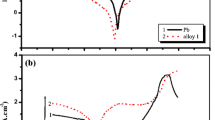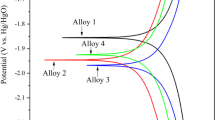Abstract
As an important part of lead-acid batteries, the grid is mainly used to support active substances and conduct current. Currently, Pb-Ca-Sn-Al alloys are widely used as materials for valve-regulated lead-acid battery grids. The influence of bismuth, barium, strontium, and germanium as alloying additives on the physical and electrochemical behaviors of Pb-Ca-Sn-Al alloys was studied by the methods of metallographic, cyclic voltammetry, linear scanning voltammetry, AC impedance, and scanning electron microscopy. The results show that the addition of Bi and Ba can increase the grain size of the alloy and reduce the intergranular corrosion and corrosion rate of Pb-Ca-Sn-Al alloy. Furthermore, the addition of Bi and Ba could inhibit the growth of Pb (II) and PbO2 in corrosion layer and improve the corrosion resistance of the alloy. Significantly, Bi and Ba will reduce the oxygen evolution overpotential of the alloy by about 30 mV, which will play important roles on the maintenance-free performance of lead-acid batteries. Both Sr and Ge promote the grain corrosion and intergranular corrosion of the alloy, reducing the corrosion resistance of the alloy. Therefore, improving the performance and corrosion life of the grid by using additives is an important approach to further extending the service life of lead-acid batteries.








Similar content being viewed by others
References
Lannelongue J, Cugnet M, Guillet N, Kirchev A (2017) Electrochemistry of thin-plate lead-carbon batteries employing alternative current collectors. J Power Sources 352:194–207
Tong PY, Zhao RR, Zhang RB, Yi FY, Shi G, Li AJ, Chen HY (2015) Characterization of lead (II)-containing activated carbon and its excellent performance of extending lead-acid battery cycle life for high-rate partial-state-of-charge operation. J Power Sources 286:91–102
Wang LY, Zhang H, Zhang WF, Cao GP, Zhao HL, Yang YS (2017) Enhancing cycle performance of lead-carbon battery anodes by lead-doped porous carbon composite and graphite additives. Mater Lett 206:113–116
Monahov B, Pavlov D (1994) Influence of antimony on the structure and the degree of hydration of the anodic PbO2 layer formed on Pb-Sb electrodes. J Electrochem Soc 141(9):2316–2326
Li DG, Zhou GS, Zhang J, Zheng MS (2007) Investigation on characteristics of anodic film formed on PbCaSnCe alloy in sulfuric acid solution. Electrochim Acta 52(5):2146–2152
Prengaman RD (2001) Challenges from corrosion-resistant grid alloys in lead acid battery manufacturing. J Power Sources 95(1-2):224–233
Rocca E, Steinmetz J, Weber S (1999) Mechanism of formation of dense anodic films of PbO on lead and lead alloys in sulfuric acid: use of an 18 O tracer. J Electrochem Soc 146(1):54–58
Caillerie JL, Albert L (1997) Lead-calcium alloy development: quality improvement. J Power Sources 67(1-2):279–281
Lam LT, Haigh NP, Rand DAJ, Manders JE (2000) Further demonstration of improved performance from lead-acid batteries manufactured with bismuth-bearing high-purity lead. J Power Sources 88(1):2–10
Lam LT, Haigh NP, Rand DAJ (2000) Understanding the mechanism by which bismuth improves lead-acid battery capacity. J Power Sources 88(1):11–17
Li AJ, Cheni Y, Chen HY, Shu D, Li WS, Wang H, Dou CL, Zhang W, Chen S (2009) Electrochemical behavior and application of lead-lanthanum alloys for positive grids of lead-acid batteries. J Power Sources 189(2):1204–1211
Furukawa J, Nehyo Y, Shiga S (2004) Development of new positive-grid alloy and its application to long-life batteries for automotive industry. J Power Sources 133(1):25–31
Lam LT, Douglas JD, Pillig R, Rand DAJ (1994) Minor elements in lead materials used for lead/acid batteries 1. Hydrogen- and oxygen-gassing characteristics. J Power Sources 48(1-2):219–232
Chen HY, Li S, Li AJ, Shu D, Li WS, Dou CL, Wang Q, Xiao GM, Peng SG, Chen S, Zhang W, Wang H (2007) Lead-samarium alloys for positive grids of valve-regulated lead-acid batteries. J Power Sources 168(1):79–89
Li DG, Wang JD, Chen DR (2012) Influence of ytterbium on the electrochemical property of PbCaSn alloy in sulfuric acid solution. J Power Sources 210:163–171
Lakshmi CS, Manders JE, Rice DM (1998) Structure and properties of lead-calcium-tin alloys for battery grids. J Power Sources 73(1):23–29
Bose CSC, Hampson NA (1987) A review of oxygen recombination in the sealed lead-acid cell. J Power Sources 19(4):261–267
Tang LP, Li AJ, Chen HY, Li H, Chen Q, Zhou HW, Wei WW, Zhang W, Hu J, Dou CL, Wang H, Finlow D (2011) The electrochemical performances of a novel lead-sodium binary grid alloy for lead-acid batteries. Electrochim Acta 56(12):4566–4570
Liu HT, Zhang XH, Zhou YB, Yang CX, Zhou WF (2003) The anodic films on lead alloys containing rare-earth elements as positive grids in lead acid battery. Mater Lett 57(29):4597–4600
Zhou WF, Cheng XL (1985) The anodic film of lead-antimony alloys in sulfuric acid solution-I. The kinetics of the early stage anodic film growth. Acta Chim Sin 43:333–339
Pavlov D, Poulieff CN, Klaja E, Iordanov N (1969) Dependence of the composition of the anodic layer on the oxidation potential of lead in sulfuric acid. J Electrochem Soc 116(3):316–319
Liu HT, Yang J, Liang HH, Zhuang JH, Zhou WF (2001) Effect of cerium on the anodic corrosion of Pb-Ca-Sn alloy in sulfuric acid solution. J Power Sources 93(1-2):230–233
Shervedani RK, Isfahani AZ, Khodavisy R, Hatefi-Mehrjardi A (2007) Electrochemical investigation of the anodic corrosion of Pb-Ca-Sn-Li grid alloy in H2SO4 solution. J Power Sources 164(2):890–895
Pour-Ali S, Aghili MM, Davoodi A (2015) Electrochemical corrosion behavior of Pb-Ca-Sn-Sm grid alloy in H2SO4 solution. J Alloys Compd 652:172–178
Li H, Guo WX, Chen HY, Finlow DE, Zhou HW, Dou CL, Xiao GM, Peng SG, Wei WW, Wang H (2009) Study on the microstructure and electrochemical properties of lead-calcium-tin-aluminum alloys. J Power Sources 191(1):111–118
Guo WX, Shu D, Chen HY, Li AJ, Wang H, Xiao GM, Dou CL, Peng SG, Wei WW, Zhang W, Zhou HW, Chen S (2009) Study on the structure and property of lead tellurium alloy as the positive grid of lead-acid batteries. J Alloys Compd 475(1-2):102–109
Wu YM, Zhao RR, Zhou HW, Zhang DJ, Zhao W, Chen HY (2016) Synthesis and application of a novel Cu/RGO@Pb alloy for lead-acid batteries. Electrochim Acta 222:116–122
Acknowledgements
We acknowledge the assistance and guidance of Dr. Boris Monahov from the Advanced Lead Acid Battery Consortium (International Lead Association) with this project.
Author information
Authors and Affiliations
Corresponding author
Additional information
Publisher’s note
Springer Nature remains neutral with regard to jurisdictional claims in published maps and institutional affiliations.
Rights and permissions
About this article
Cite this article
Yang, B., Cai, X., Li, E. et al. Evaluation of the effect of additive group five elements on the properties of Pb-Ca-Sn-Al alloy as the positive grid for lead-acid batteries. J Solid State Electrochem 23, 1715–1725 (2019). https://doi.org/10.1007/s10008-019-04265-x
Received:
Revised:
Accepted:
Published:
Issue Date:
DOI: https://doi.org/10.1007/s10008-019-04265-x




